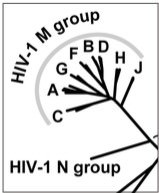10.32 微进 - 先进
章节大纲
-
Why do humans vary in skin color?
::为什么人类的肤色不同?Is this the result of a change in allele frequencies ? Is this an example of evolution within a ? The answer to both these questions is yes. And this is an example of microevolution .
::这是Allee频率变化的结果吗?这是进化的例子吗?这两个问题的答案是肯定的。这是微进的例子。Microevolution
::微进-
How many people in the United States carry the
recessive
for the lethal genetic disease,
cystic fibrosis
?
::美国有多少人携带致命基因疾病, 囊肿纤维化的休眠药? -
Why must we treat AIDS patients with multi-
drug
“cocktails?”
::为什么我们必须用多种毒品“鸡尾酒”治疗艾滋病患者? -
Why do we consider Northern Elephant seals endangered, even though their
has risen to 100,000 individuals?
::我们为什么认为北象海豹濒临灭绝, 尽管它们已经上升到10万人? -
Why don’t South African Cheetahs reject skin grafts from unrelated individuals?
::南非Cheetahs为何不拒绝来自无关个人的皮肤移植? -
What were the probable effects on human evolution of the six years of “volcanic winter” caused by the “megacollosal” eruption of Mt. Toba 70,000 years ago?
::70 000年前托巴山的“巨石”喷发造成的六年“火山冬天”对人类进化可能产生的影响是什么? -
Why doesn’t
eliminate certain lethal
genes
?
::为何不消除某些致命基因? -
Why do humans vary in skin color?
::为什么人类的肤色不同?
This concept will introduce you to our current understanding of the causes of evolution and show you how scientists use this understanding to solve problems and answer puzzling questions like those above.
::这个概念将向你们介绍我们目前对进化原因的理解,并向你们展示科学家如何利用这种理解解决问题,并回答上述令人费解的问题。In an earlier concept, we defined microevolution as evolution within a species or population, and macroevolution was defined as evolution at or above the level of species. The differences between the two are time and scale. Microevolution can refer to changes as small as a shift in allele frequencies for a single gene from one generation to the next. In contrast, macroevolution describes changes in species over geologic time. Many biologists consider evolution to be a single process; they regard macroevolution as the cumulative effects of microevolution. The concepts discussed patterns and processes of macroevolution; this lesson will focus on genetic changes within populations and species. At this level, we can see how evolution really works – a view that never had.
::在早期的概念中,我们将微进定义为物种或种群内部的进化,而宏观进化被定义为在物种水平上或上层的进化。两者之间的差异是时间和规模的。微进化可以指单个基因的异位频率从一代向下一代的变异等小的变化。相反,宏观进化可以描述物种在地理时间的变化。许多生物学家认为演化是一个单一的过程;他们把宏观进化视为微进的累积效应。概念讨论了宏观进化的模式和过程;这一教训将侧重于种群和物种内部的基因变化。在这个层次,我们可以看到进化是如何真正起作用的 — — 这种观点从未有过。A change in allele frequencies within a population from one generation to the next – even if it involves only a single gene - is evolution. Biologists refer to this change in the gene pool as microevolution because it is evolution on the smallest scale. For our rabbit population from the previous lesson, a generation-to-generation increase in the frequency of the albino allele, b, from 0.3 to 0.4 (and the corresponding decrease in the frequency of allele B from 0.7 to 0.6) would be microevolution. The changes in Galapagos finch beak size, documented by Peter and Rosemary Grant, and the color changes of peppered moths will undoubtedly show corresponding changes in allele frequencies once we identify the responsible genes and alleles. Resistance to antibiotics in and the appearance of new strains of influenza and ( Figure ) also involve changes in allele frequencies. Each of these are examples of microevolution.
::从一代人到下一代人之间不同频率的变化 — — 即使只涉及单一基因 — — 也是进化。 生物学家认为基因库中的这种变化是微变,因为它是最小规模的演化。 对于我们的兔子来说,从以往的教训来看,白化虫的频率从0.3到一代增加,b,从0.4(以及Alle B的频率从0.7到0.6的相应下降)将是微变。 彼得和罗斯玛丽·格兰特所记载的加拉帕戈斯finch beak大小的变化,以及胡椒藻的颜色变化,毫无疑问,一旦我们确定了负责任的基因和虫类,就会显示Allen频率的相应变化。 对抗生素的抵抗以及流感和(图示 )新菌株的出现也涉及到所有细胞频率的变化。 所有这些都是微变的例子。This portion of the evolutionary tree for Human Immunodeficiency Virus (HIV) shows 8 or more strains of the HIV-1 M (Main) group and a single strain of the HIV-1 N (Not Main/Not Outlier) group. The complete tree includes strains of SIV (Simian Immunodeficiency Virus). Each strain represents a change in allele frequencies. What forces cause changes in allele frequencies? What mechanisms determine how microevolution happens? Before we tackle these questions, we will examine a population at equilibrium – a population that is not evolving.
::是什么力量导致Altele频率的变化?什么机制决定了微进如何发生?在解决这些问题之前,我们将在平衡中审查人口 — — 即没有变化的人口。Summary
::摘要-
Macroevolution is the change in species over geologic time; it is the cumulative effect of microevolution.
::宏观进化是相对于地质时间的物种变化;这是微进的累积效应。 -
Microevolution is evolution within species or populations; it can be measured as a generation-to-generation change in allele frequencies.
::微进是物种或种群内部的演变;可以计量为Altele频率代代相传的变化。
Review
::回顾-
Compare microevolution to macroevolution.
::将微观进化与宏观进化作比较。 -
Define microevolution in terms of allele frequencies.
::用Allele频率来定义微进。
-
How many people in the United States carry the
recessive
for the lethal genetic disease,
cystic fibrosis
?

